
A sailing vessel's rig is its arrangement of masts, sails and rigging. Examples include a schooner rig, cutter rig, junk rig, etc. A rig may be broadly categorized as "fore-and-aft", "square", or a combination of both. Within the fore-and-aft category there is a variety of triangular and quadrilateral sail shapes. Spars or battens may be used to help shape a given kind of sail. Each rig may be described with a sail plan—formally, a drawing of a vessel, viewed from the side.
A jib is a triangular sail that sets ahead of the foremast of a sailing vessel. Its tack is fixed to the bowsprit, to the bows, or to the deck between the bowsprit and the foremost mast. Jibs and spinnakers are the two main types of headsails on a modern boat.

A staysail ("stays'l") is a fore-and-aft rigged sail whose luff can be affixed to a stay running forward from a mast to the deck, the bowsprit, or to another mast.
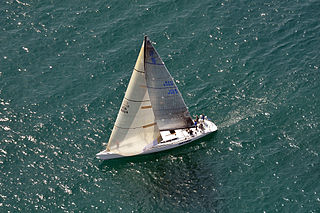
A genoa sail is a type of large jib or staysail that extends past the mast and so overlaps the main sail when viewed from the side, sometimes eliminating it. It was originally called an "overlapping jib" and later a genoa jib. It is used on single-masted sloops and twin-masted boats such as yawls and ketches. Its larger surface area increases the speed of the craft in light to moderate winds; in high wind, a smaller jib is usually substituted, and downwind a spinnaker may be used.
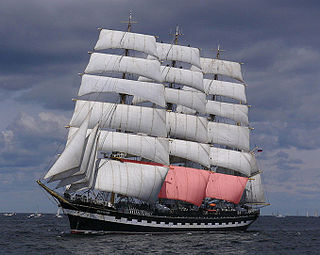
A mainsail is a sail rigged on the main mast of a sailing vessel.

Gaff rig is a sailing rig in which the sail is four-cornered, fore-and-aft rigged, controlled at its peak and, usually, its entire head by a spar (pole) called the gaff. Because of the size and shape of the sail, a gaff rig will have running backstays rather than permanent backstays.

Sail components include the features that define a sail's shape and function, plus its constituent parts from which it is manufactured. A sail may be classified in a variety of ways, including by its orientation to the vessel and its shape,. Sails are typically constructed out of flexible material that is shaped by various means, while in use, to offer an appropriate airfoil, according to the strength and apparent direction of the wind. A variety of features and fittings allow the sail to be attached to lines and spars.

In sailing, a boom is a spar (pole), along the of a fore and aft rigged sail, that greatly improves control of the angle and shape of the sail. The primary action of the boom is to keep the foot flatter when the sail angle is away from the centerline of the boat. The boom also serves as an attachment point for more sophisticated control lines. Because of the improved sail control it is rare to find a non-headsail without a boom, but lateen sails, for instance, are loose-footed. In some modern applications, the sail is rolled up into the boom for storage or reefing.

Reefing reduces the area of a sail, usually by folding or rolling one edge of the canvas in on itself and attaching the unused portion to a spar or a stay, as the primary measure to preserve a sailing vessel's stability in strong winds. Restoring full sail area is termed shaking out a reef.

A fractional rig on a sailing vessel consists of a foresail, such as a jib or genoa sail, that does not reach all the way to the top of the mast.
A mast-aft rig is a sailboat sail-plan that uses a single mast set in the aft half of the hull. The mast supports fore-sails that may consist of a single jib, multiple staysails, or a crab claw sail. The mainsail is either small or completely absent. Mast-aft rigs are uncommon, but are found on a few custom, and production sailboats.

The Astus 16.1 is a 16 ft (5.1m) trimaran dinghy aimed at family day sailing. Its design has been optimised for simplicity of use: the traditional centreboard on the main hull has been replaced by foils built in each float.
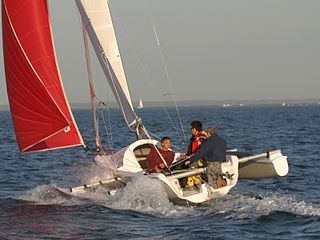
The Astus 20.1, built by Astusboats, is a 20 ft (6.1m) trimaran dinghy aimed at family day sailing, though its cabin offers basic cruising capability. Its multihull design offers speed and stability.
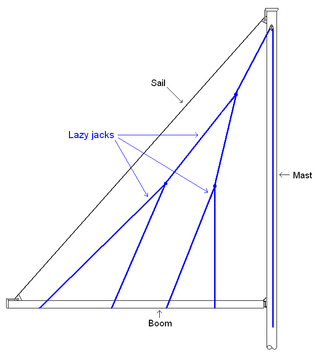
Lazy jacks are a type of rigging which can be applied to a fore-and-aft rigged sail to assist in sail handling during reefing and furling. They consist of a network of cordage which is rigged to a point on the mast and to a series of points on either side of the boom; these lines form a cradle which helps to guide the sail onto the boom when it is lowered, reducing the crew needed to secure the sail. Lazy jacks are most commonly associated with Bermuda rigged sails, although they can be used with gaff rigged sails and with club-footed jibs. Blocks and rings may be part of some lazyjacks.
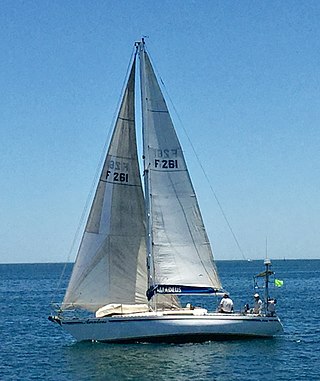
A masthead rig on a sailing vessel consists of a forestay and backstay both attached at the top of the mast.

Ljungström sailboats were created by the Swedish engineer Fredrik Ljungström, who was interested in sailing since childhood. A "Ljungström sailboat" typically has a "circular arc" hull and a "Ljungström rig". A Ljungström rig mast has no mast stays. The mast rotates on two ball bearings often flying double mainsails, with no foresails. In their time the Ljungström sailboats were a minor revolution as they were fast, safe and easy to sail as well as relatively easy and affordable to produce.

A sail is a tensile structure, which is made from fabric or other membrane materials, that uses wind power to propel sailing craft, including sailing ships, sailboats, windsurfers, ice boats, and even sail-powered land vehicles. Sails may be made from a combination of woven materials—including canvas or polyester cloth, laminated membranes or bonded filaments, usually in a three- or four-sided shape.
The Freedom 25 is an American sailboat that was designed by Gary Hoyt as a single-handed racer-cruiser and first built in 1980.
A solent refers to a sail and rigging system on sailboats, typically sloops. Sailors, particularly British sailors, often refer to a 100% jib as a Solent, because its smaller size is preferable when sailing in the strong winds found in the Solent between the Isle of Wight and Britain. The common use of roller-furling headsails, or genoas, on modern cruising yachts allows the jib to be reduced in size, but partially-furled sails lack the efficiency of a sail that is actually cut to a smaller size. Accordingly, it is preferable to fly a separate, smaller jib—the solent—instead.

A sail plan is a drawing of a sailing craft, viewed from the side, depicting its sails, the spars that carry them and some of the rigging that supports the rig. By extension, "sail plan" describes the arrangement of sails on a craft. A sailing craft may be waterborne, an iceboat, or a sail-powered land vehicle.


















